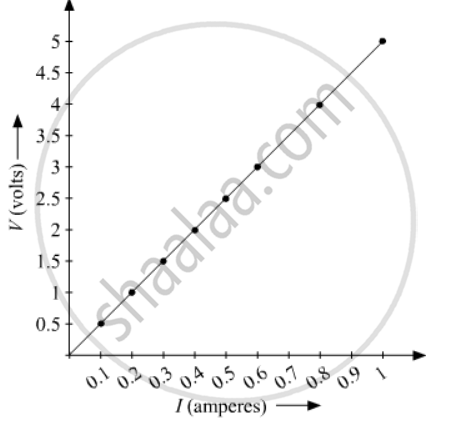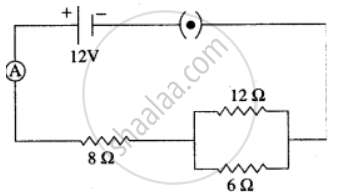Advertisements
Advertisements
प्रश्न
The values of current (I) flowing through a given resistor of resistance (R), for the corresponding values of potential difference (V) across the resistor are as given below:
| V (volts) | 0.5 | 1.0 | 1.5 | 2.0 | 2.5 | 3.0 | 4.0 | 5.0 |
| I (amperes) | 0.1 | 0.2 | 0.3 | 0.4 | 0.5 | 0.6 | 0.8 | 1.0 |
Plot a graph between current (I) and potential difference (V) and determine the resistance (R) of the resistor.
उत्तर
The plot between current (I) and potential difference (V) is given as,

Resistance of the resistor = Slope of the above graph
Chose two points A and B on the graph,

Slope of the graph is = Slope of line AB = `(4-1)/(0.8-0.2) = 3/0.6` = 5 Ω
APPEARS IN
संबंधित प्रश्न
Calculate the quantity of heat produced in a 20 Ω resistor carrying 2.5 A current in 5 minutes.
How much work is done when one coulomb charge moves against a potential difference of 1 volt?
What is the unit of electric charge?
Calculate the work done in moving a charge of 4 coulombs from a point at 220 volts to another point at 230 volts.
What is Ohm's law? Explain how it is used to define the unit of resistance.
What is the ratio of potential difference and current known as?
The V-I graph for a series combination and for a parallel combination of two resistors is shown in Fig – 8.38. Which of the two, A or B, represents the parallel combination? Give a reason for your answer.
Define the following:
Potential difference
Three resistors are connected to a 12 V battery as shown in the figure given below:

(i) What is the current through the 8 ohm resistor?
(ii) What is the potential difference across the parallel combination of 6 ohm and 12 ohm resistor?
(iii) What is the current through the 6 ohm resistor?
What does the positive and negative sign of potential convey?
